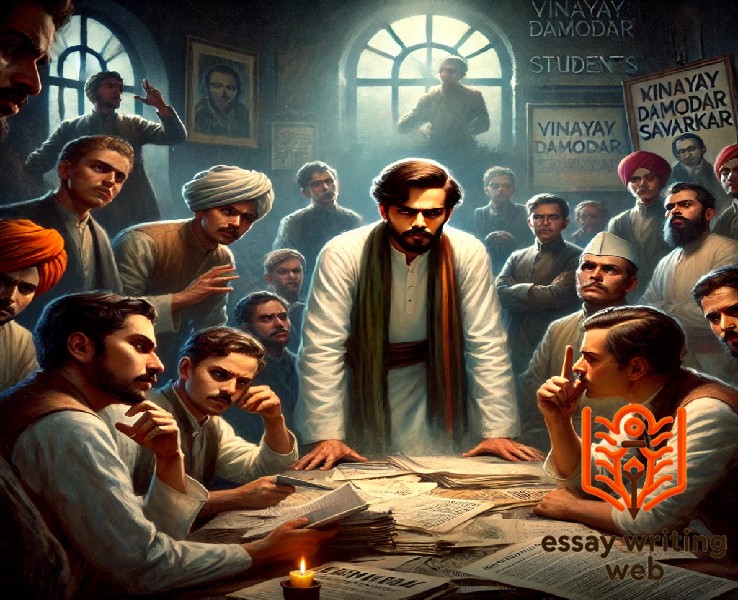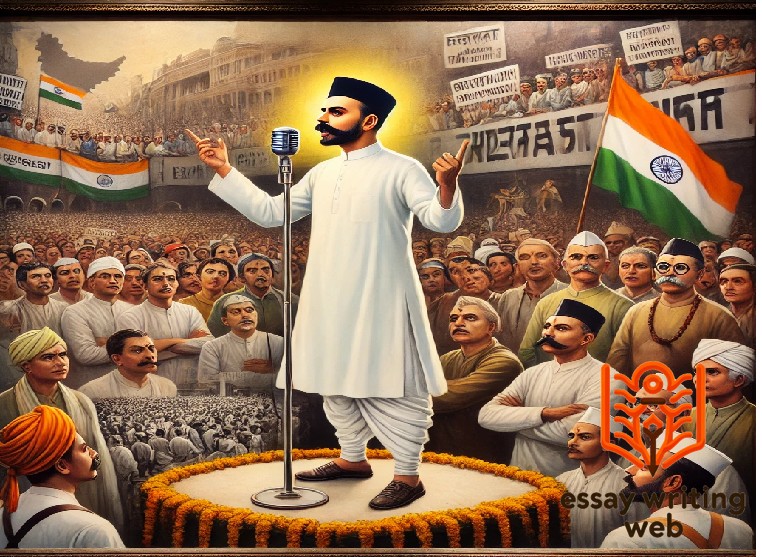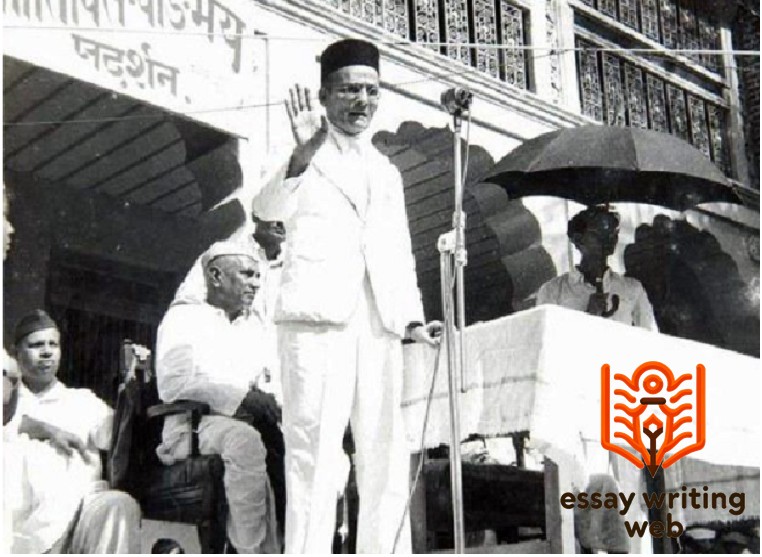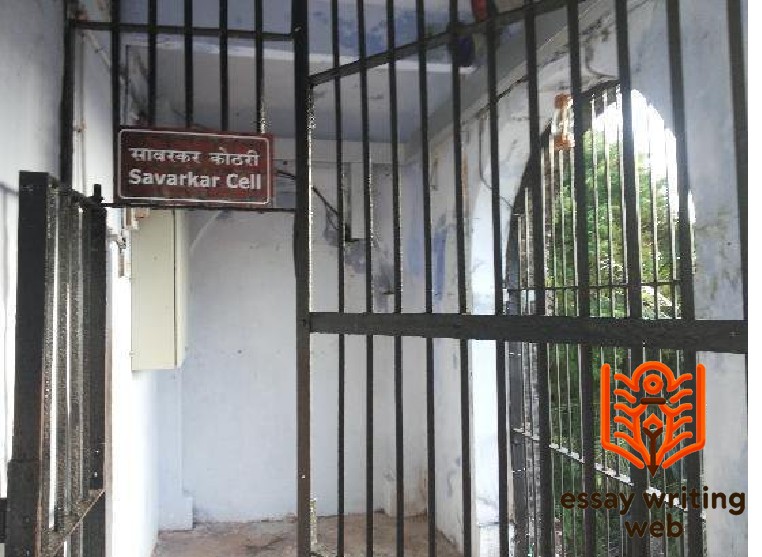 Essay Writing Web
Essay Writing Web

 02-09-2024
02-09-2024
 www.essaywritingweb.com
www.essaywritingweb.com
Vinayak Damodar Savarkar, often referred to as Veer Savarkar, was a multifaceted personality in India's struggle for independence. Born on May 28, 1883, in the village of Bhagur, near Nashik, Maharashtra, Savarkar emerged as a significant figure in the early 20th century, known for his radical and revolutionary ideas. A staunch nationalist, he was an ardent advocate of freedom from British rule and contributed immensely to the ideological framework that inspired many freedom fighters.
Savarkar's life was marked by his unyielding commitment to the cause of Indian independence. He was a prolific writer, poet, historian, and political leader who sought to instill a sense of pride and identity among Indians through his concept of Hindutva. His work "The First War of Indian Independence," written during his imprisonment, challenged the British narrative and offered a different perspective on the 1857 uprising.
Savarkar's revolutionary activities, including his involvement in the formation of the Abhinav Bharat Society, an organization that advocated armed rebellion against British rule, led to his arrest and subsequent imprisonment in the dreaded Cellular Jail in Andaman Islands. Despite the harsh conditions Savarkar continued to inspire others with his unbroken spirit and his writings.
While Savarkar's contributions to the independence movement are undeniable, his legacy remains a subject of debate. His advocacy of Hindutva and his views on religious and cultural nationalism have made him a polarizing figure in contemporary India. However, his dedication to the cause of India's freedom and his intellectual contributions continues to be recognized and studied by scholars and patriots alike.
In summary, Vinayak Damodar Savarkar was a complex and influential figure whose life and work left an indelible mark on India's history. His vision of a free and self-reliant India, coupled with his relentless efforts towards achieving that goal, makes him a significant personality in the annals of India's struggle for independence.
Vinayak Damodar Savarkar, one of the most prominent figures in India's struggle for independence, was born on May 28, 1883, in the small village of Bhagur, located in the Nashik district of Maharashtra. His family belonged to the Chitpavan Brahmin community, known for their strong emphasis on education, culture, and patriotism. The environment in which Savarkar was raised played a crucial role in shaping his ideas and instilling in him a deep sense of nationalism.
Savarkar's father, Damodar Pant Savarkar, was a well-educated man who worked as a landlord and was deeply involved in local social and political activities. Damodar Pant was known for his progressive views and was a firm believer in the importance of education, which he ensured was a significant part of his children's upbringing. His mother, Radhabai, was a pious and devout woman who greatly influenced Savarkar's moral and ethical outlook. The family was steeped in the values of patriotism and social reform, which would later become the bedrock of Savarkar's revolutionary ideas.
Vinayak was the third of four children in the Savarkar family. He had two brothers, Ganesh (affectionately called Babarao) and Narayan, and a sister named Maina. The close-knit family faced several hardships, especially after the untimely death of their parents when Vinayak was still a young boy. Despite these challenges, the Savarkar siblings remained united and continued to pursue the values instilled in them by their parents.
The influence of his elder brother, Babarao, was particularly significant in Vinayak's early life. Babarao was deeply involved in the struggle for India's independence and was an early mentor to Vinayak. Under Babarao's guidance, Vinayak was exposed to the works of Indian and foreign revolutionaries, which ignited his passion for the freedom movement.
The environment at home, combined with the socio-political atmosphere of the time, profoundly shaped Savarkar's worldview. The village of Bhagur, though small, was a hotbed of revolutionary activities, and young Vinayak was exposed to discussions on national issues, the oppression of the British rule, and the need for armed resistance to achieve independence. These early experiences sowed the seeds of rebellion in Savarkar's mind and laid the foundation for his later contributions to the freedom struggle.
Vinayak Damodar Savarkar, known for his fierce patriotism and revolutionary zeal, began his involvement in the struggle for India's independence during his student years. His time as a student was marked by a deepening commitment to the cause of freedom and a growing involvement in revolutionary activities that would eventually lead him to become one of the most influential figures in India's fight against British rule.
Savarkar's revolutionary inclinations began to take shape during his early education. He was an exceptionally bright student, with a keen interest in history, politics, and literature. These subjects fueled his desire to understand the forces that had subjugated India under British rule. As a young boy, he was already influenced by the stories of India's glorious past and the valor of its heroes, which sowed the seeds of rebellion in his mind.
In 1902, Savarkar moved to Pune, where he enrolled at Fergusson College. This move was pivotal in his revolutionary journey. Pune, at the time, was a hub of political and intellectual activity, with many young Indians eager to overthrow British rule. It was here that Savarkar's latent revolutionary spirit found expression. He quickly became involved with a group of like-minded students who shared his passion for Indian independence.
Savarkar's leadership qualities soon became apparent, and he formed a secret society called "Mitra Mela" in 1904, which later evolved into the more organized and radical "Abhinav Bharat Society." The organization was committed to the idea of complete independence for India, a notion far more radical than the moderate demands for self-rule that were popular at the time. Abhinav Bharat's activities included the dissemination of revolutionary literature, planning armed resistance against the British, and fostering a spirit of nationalism among the youth.
During his time at Fergusson College, Savarkar also wrote extensively, producing poems, articles, and pamphlets that called for a united and armed struggle against the British. His writings, imbued with fiery rhetoric and revolutionary fervor, were circulated among students and young nationalists, inspiring many to join the cause. One of his most notable works from this period was a biography of Giuseppe Mazzini, the Italian revolutionary, which Savarkar translated into Marathi. Mazzini's ideas of nationalism and armed rebellion greatly influenced Savarkar and shaped his revolutionary ideology.
Savarkar's revolutionary activities soon attracted the attention of the British authorities, who were growing increasingly wary of the burgeoning nationalist movement among Indian students. Despite the risks, Savarkar remained undeterred, continuing to advocate for armed resistance and encouraging his peers to take up the cause of independence with renewed vigor.
In 1906, Savarkar won a scholarship to study law at Gray's Inn in London. While this opportunity was intended to further his legal education, it also allowed him to connect with a broader network of Indian revolutionaries in Europe. In London, Savarkar's involvement in revolutionary activities deepened. He continued to lead the Abhinav Bharat Society from afar and became a central figure in the India House, a hub for Indian nationalists in London. It was during this period that Savarkar authored "The First War of Indian Independence," a history of the 1857 uprising, which he framed as India's first concerted effort to overthrow British rule.
Savarkar's activities in London eventually to his arrest and deportation to India, where he was sentenced to life imprisonment in the infamous Cellular Jail in the Andaman Islands. However, his student years laid the foundation for a lifelong commitment to India's independence and established him as a key figure in the revolutionary movement.

Vinayak Damodar Savarkar, often known as Veer Savarkar, was a revolutionary leader whose contributions to the Indian independence movement were both profound and controversial. His life was marked by a relentless pursuit of freedom for India from British colonial rule, and his efforts significantly influenced the trajectory of the struggle for independence.
Savarkar's role in the Indian independence movement can be understood through his leadership in revolutionary activities, his ideological contributions, and his unwavering commitment to the cause of independence. His journey from a young revolutionary to a key figure in India's freedom struggle showcases his deep dedication and the lengths he was willing to go to achieve his vision of a free India.
Savarkar's involvement in revolutionary activities began during his student years, where he founded the Abhinav Bharat Society, a secret organization dedicated to armed resistance against British rule. The society attracted young revolutionaries who were disillusioned with the moderate approach of the Indian National Congress and were seeking more direct action to achieve independence.
Savarkar's most significant contribution during this time was his role in organizing and inspiring revolutionary activities across India. He was instrumental in the dissemination of revolutionary literature, including his translation of Giuseppe Mazzini's works, which influenced many young Indians. Savarkar believed that only through armed struggle could India achieve complete independence, and he actively encouraged and participated in efforts to acquire weapons and plan uprisings against the British.
One of the most notable episodes in Savarkar's revolutionary career was his involvement in the 1909 assassination of A.M.T. Jackson, the British district magistrate of Nashik. Although Savarkar did not carry out the assassination himself, he was accused of supplying the revolver used in the killing. This event led to his arrest in London in 1909 and subsequent trial in India, where he was sentenced to life imprisonment and deported to the Cellular Jail in Andaman Islands, known for its harsh conditions.
Savarkar's role in the independence movement extended beyond his revolutionary activities; he was also a prolific writer and thinker whose ideas left a lasting impact on Indian nationalism. His most influential work, "The First War of Indian Independence," offered a revisionist history of the 1857 uprising, portraying it as a unified and deliberate attempt by Indians to overthrow British rule. This work challenged the British narrative of the event and provided a source of inspiration for future generations of freedom fighters.
Savarkar is also known for his articulation of the concept of Hindutva which he detailed in his book Hindutva: Who is a Hindu? Published in 1923, this work laid out his vision of India as a Hindu nation, where cultural and religious identity played a central role in defining Indian nationalism. While his ideas were controversial and have been the subject of much debate, they nonetheless shaped the discourse on Indian identity and nationalism during the struggle for independence and beyond.
Savarkar's commitment to the cause of independence never wavered, even during his imprisonment in the Cellular Jail, where he endured years of solitary confinement and hard labor. Despite the brutal conditions, he continued to write and inspire others, using whatever means available to him to further the cause of India's freedom.
After his release in 1924, Savarkar continued to be involved in political activities, though he shifted towards advocating for social reform and the consolidation of Hindu identity in the context of Indian nationalism. He became the president of the Hindu Mahasabha, a political party that sought to protect Hindu interests and promote the idea of a Hindu nation. His involvement with the Hindu Mahasabha, however, led to further controversy, particularly after Mahatma Gandhi's assassination in 1948, when Savarkar was accused, though later acquitted, of being involved in the conspiracy.
Savarkar's legacy in the Indian independence movement is complex. While he is celebrated by many as a fierce nationalist and a hero of the freedom struggle, others critique his ideology and the divisive nature of his politics. Nevertheless, his contributions to the fight for independence and his role in shaping Indian nationalism are undeniable.

Savarkar’s involvement in the Swadeshi movement went beyond rhetoric; he actively participated in efforts to promote indigenous products and industries. He was instrumental in organizing protests, boycotts, and demonstrations against the use of British goods. His leadership in these activities galvanized support among the youth, particularly students, who were drawn to his passionate advocacy for Swadeshi.
One of Savarkar's notable contributions was his emphasis on the production and use of indigenous goods as a form of resistance. He encouraged the establishment of local industries and businesses that could produce goods that were otherwise imported from Britain. This approach was not only a rejection of foreign products but also a step towards building a self-reliant economy that could sustain an independent India. Through his writings, speeches, and actions, Savarkar inspired many to take pride in Indian-made products and to support local artisans and manufacturers.

Vinayak Damodar Savarkar, a prominent leader in the Indian independence movement, endured one of the most harrowing experiences in the history of India’s struggle for freedom—his imprisonment and deportation to the notorious Cellular Jail in Andaman and Nicobar Islands. This period of his life not only tested his resolve but also solidified his position as a symbol of resistance against British colonial rule.
Savarkar’s involvement in revolutionary activities and his advocacy for armed resistance against British rule made him a prime target for colonial authorities. Jackson, the British district magistrate of Nashik, led to his arrest in London in 1909. Savarkar was charged with conspiring to overthrow the British government was put on trial.
Despite his attempts to evade arrest, including a daring escape attempt during his transfer from London to India, Savarkar was eventually apprehended and brought back to India. In a high-profile trial that drew widespread attention, he was found guilty of sedition and conspiracy against the British crown. The British government, recognizing the threat posed by Savarkar's revolutionary ideas and his influence on the Indian populace, decided to make an example of him. He was sentenced to life imprisonment in 1911, was deported to the Cellular Jail in the Andaman and Nicobar Islands, also known as "Kala Pani."
The Cellular Jail, located on a remote island, was infamous for its brutal conditions and the inhumane treatment of prisoners. It was reserved for the most dangerous political prisoners, who were isolated from the rest of the world to prevent them from spreading their revolutionary ideas. The jail was designed to break the spirit of even the most resilient inmates, with its solitary confinement cells, hard labor, and frequent physical and psychological torture.
Savarkar's life in the Cellular Jail was marked by immense suffering. He was subjected to solitary confinement in a small, dark cell with minimal ventilation. The prisoners were forced to perform grueling tasks, such as crushing stones and extracting oil from coconuts, under the scorching sun. The lack of adequate food, medical care, and basic amenities further compounded the misery of the prisoners.
Despite the extreme hardships, Savarkar remained resolute. His indomitable spirit and unwavering commitment to the cause of Indian independence inspired other prisoners. Even in the face of such adversity, Savarkar continued to write and compose poetry, using whatever materials he could find. His poems, often composed in the darkness of his cell and memorized due to the lack of writing tools, reflected his enduring love for his motherland and his hope for its eventual liberation.
Savarkar's imprisonment in the Cellular Jail did not go unnoticed. News of his harsh treatment spread across India and garnered sympathy and support for the independence movement. The British authorities, realizing that Savarkar's continued imprisonment was turning him into a martyr, eventually transferred him to a jail in mainland India in 1921, after nearly a decade of confinement in the Andamans.
Although his physical freedom was severely restricted during this period, Savarkar's influence on the Indian freedom struggle only grew. His writings, smuggled out of the prison, reached the outside world and inspired many to join the cause of independence. His resolve in the face of unimaginable hardship became a rallying point for nationalists who sought to overthrow British rule.
Savarkar's time in the Cellular Jail also had a profound impact on his ideological beliefs. The harsh realities of colonial repression reinforced his conviction that India could only achieve true independence through complete self-reliance and a strong sense of national identity. These ideas later became central to his concept of Hindutva, which emphasized the importance of cultural unity and national pride.

Vinayak Damodar Savarkar, often hailed as a revolutionary hero and a pioneer of the Indian independence movement, has left a lasting legacy in the nation's history. His contributions to the freedom struggle, his ideological influence, and his vision for a free India have been recognized through various memorials and honors across the country. These memorials serve as a testament to his enduring influence and the respect he commands among many Indians, even as his legacy remains complex and sometimes controversial.
One of the most prominent memorials dedicated to Vinayak Damodar Savarkar is the Savarkar Smarak (Savarkar Memorial) in Mumbai, located at the site of his residence in Dadar. This memorial, also known as Swatantryaveer Savarkar Rashtriya Smarak, serves as a cultural and educational center that aims to preserve and promote Savarkar's legacy. The Smarak includes a museum that houses artifacts from Savarkar's life, including his personal belongings, letters, and photographs, providing visitors with a glimpse into the life of the man who played a pivotal role in India's fight for freedom.
The memorial also features a library and research center dedicated to the study of Savarkar's works and the broader context of India's independence movement. Through exhibitions, seminars, and events, the Savarkar Smarak continues to engage with the public, ensuring that Savarkar's contributions are remembered and appreciated by future generations.

Another significant site associated with Savarkar is the Cellular Jail in the Andaman and Nicobar Islands, where he was imprisoned for over a decade by the British authorities. The jail, often referred to as "Kala Pani" (Black Waters), is now a national memorial and a symbol of the sacrifices made by countless freedom fighters. The memorial pays homage to the suffering endured by Savarkar and others who were confined there under brutal conditions.
Within the Cellular Jail complex, a dedicated section honors Savarkar's memory, highlighting his time in imprisonment and his role in the freedom struggle. The memorial includes a plaque commemorating his stay and exhibits detailing the harsh realities faced by the prisoners. The Cellular Jail Memorial has become a place of pilgrimage for those who wish to honor the legacy of India’s freedom fighters, and Savarkar’s story is a central narrative in this historical site.

Savarkar's home state of Maharashtra has been particularly active in recognizing his contributions. Numerous public buildings, institutions, and roads across the state have been named in his honor. The Veer Savarkar International Airport in Port Blair, Andaman and Nicobar Islands, is one such recognition, named to honor his contributions to the nation. This naming serves not only as a tribute to Savarkar but also as a reminder of his time spent in the Andaman Islands during his imprisonment.
In addition, statues of Savarkar have been erected in various cities, including a notable one at the entrance of the historic Shivaji Park in Mumbai. These statues, often placed in prominent public spaces, serve as daily reminders of Savarkar’s legacy and his role in the fight for independence. Educational institutions, such as Veer Savarkar College in Beed, Maharashtra, have also been named after him, reflecting his influence on the state’s cultural and educational landscape.
While many memorials and honors have been established to celebrate Savarkar's legacy, they have not been without controversy. Savarkar’s political ideology, particularly his formulation of Hindutva, has sparked debate and division among different sections of society. Some of his critics argue that his views were exclusionary and contributed to communal tensions in the country. These debates have, at times, influenced the decisions regarding memorials and the way his legacy is commemorated.
For instance, the installation of statues or the renaming of public spaces in Savarkar’s honor has occasionally met with opposition from those who view his legacy more critically. These controversies highlight the complexity of Savarkar's legacy, where his contributions to the independence movement are weighed against the ideological stances he took later in life.